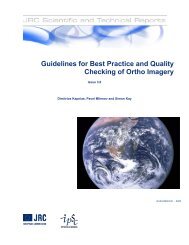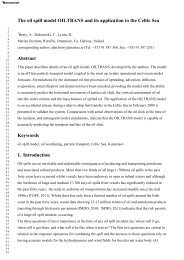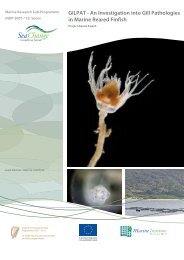Marine Industries Global Market Analysis - Marine Institute
Marine Industries Global Market Analysis - Marine Institute
Marine Industries Global Market Analysis - Marine Institute
Create successful ePaper yourself
Turn your PDF publications into a flip-book with our unique Google optimized e-Paper software.
MARINE INDUSTRIES GLOBAL MARKET ANALYSIS<br />
75<br />
Ports & harbours – €233 million (2004). Most of the tonnage of international cargo<br />
is moved by sea and this involves the use of over 7,000 ports & harbours world-wide<br />
and over 2,000 of these can be regarded as significant ports – in other words, they<br />
carry out survey work. Major commercial ports do this using in-house hydrographers<br />
although there is a small amount of contracted commercial activity.<br />
Although there is a requirement to conduct the survey of ports and harbours on an<br />
ongoing basis, the amount of money available for this process is fundamentally a<br />
function of the number of ship movements through ports.The tonnage of goods<br />
moved by sea is a function of national GDP and the above table is based on our views<br />
of regional GDP growth over the period.The routine expenditure patterns are<br />
complicated by major port development but as these tend to stretch over several years<br />
the effect is ‘smoothed’ significantly.<br />
We expect a continuing growth in port & harbour survey expenditure, with the US<br />
being by far the largest region. Here the US Army Corps of Engineers is responsible<br />
for a considerable proportion of national expenditure.<br />
Submarine cables – €16 million 2004. Route survey is a critical part of the<br />
installation of submarine cables and is now even more so due to changes in fishing<br />
and shipping activities.This activity collapsed with the end of the ‘dotcom’ stock<br />
market boom and released additional capacity into the other S&P sectors.<br />
After a rapid climb to an annual peak of nearly €104 million in 2000, the installation,<br />
and correspondingly the survey of submarine cable routes, virtually ground to a halt<br />
in 2002.This had the spin-off effect of releasing survey capacity (and ROVs working<br />
on cable burial) into the major market sector, oil & gas, elongating a period of low<br />
prices caused by the earlier oil price fall. A further, but less publicised factor was the<br />
development of technology allowing more capacity on the fibre-optic cables. A very<br />
slow upturn in business is expected as the global economy recovers.<br />
Exclusive economic zones – €23 million 2004.The definition of exclusive<br />
economic zones (EEZ) outside the 200 nautical mile limit under the United Nations<br />
Convention on Law of the Sea (UNCLOS) requires the use of S&P to determine the<br />
location of the outer edge of the continental margin at a depth of 2,500m.<br />
A successful claim can give a nation rights over hundreds of thousands of kilometres<br />
of ‘seabed real estate’ and the associated oil, gas and mineral rights.

















